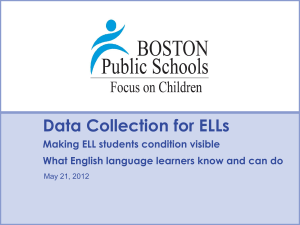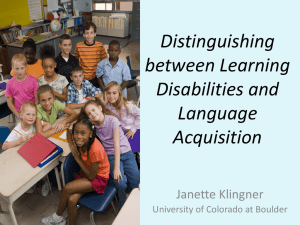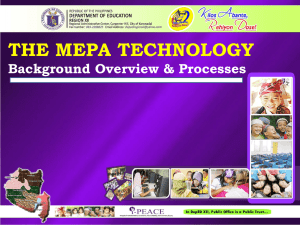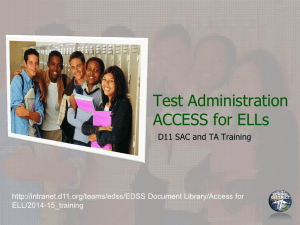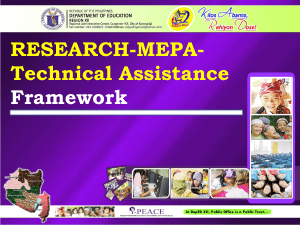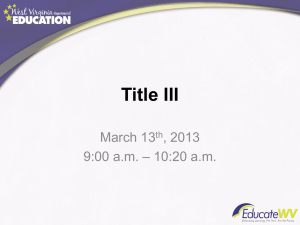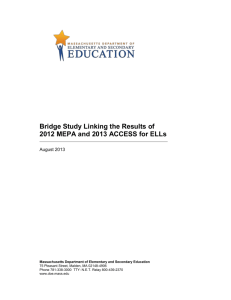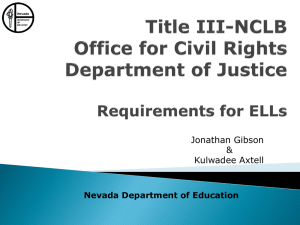Identifying Success in Schools and Programs for English Language
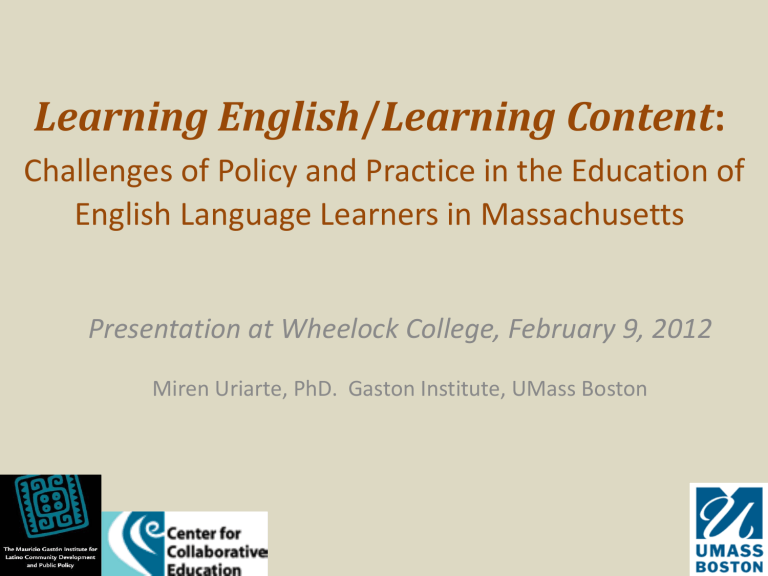
Learning English/Learning Content :
Challenges of Policy and Practice in the Education of
English Language Learners in Massachusetts
Presentation at Wheelock College, February 9, 2012
Miren Uriarte, PhD. Gaston Institute, UMass Boston
BACKGROUND
Impact Of Question 2
Federal Intervention And An Initiative For Change
The Study
2
Enrollment of
English Language Learners
BPS Enrollment, SY2009
# %
58,597 100 ALL
English
Proficient (EP)
Limited English
Proficient
(LEP, ELL)
47,267
11,690
80.2
19.8
15,0%
Change in BPS Enrollment,
SY2006-2009
12,3%
10,0%
5,0%
0,0%
-5,0%
-3,9%
-10,0%
-7,3%
All BPS EP LEP
3
Characteristics of ELLs, SY2009
Total Enrollment
Gender (% Male)
Low Income
Race/Ethnicity -
Asian
Black
Latino
White
Mobile
SWD
EP
47,267
51.5%
72.0%
7.0%
42.4%
32.9%
15.2%
8.0%
19.5%
LEP
11,690
53.6%
87.3%
14.8%
20.4%
59.4%
4.4%
12.9%
18.7%
4
Native Languages of ELLs, SY2009
Total Enrollment
Native Language
Spanish
Haitian Creole
Cape Verdean Creole
Chinese Languages
Vietnamese
Portuguese
Somali
Other languages
LEP
11,690
56.6%
9.0%
8.2%
7.8%
6.1%
2.2%
2,1%
8.1%
5
The Good News:
Decline in the LEP Dropout Rate
Annual HS Dropout Rate of ELLs. BPS, SY2006-2009
14,0%
12,0%
12,0% 11,3%
10,0%
8,6%
8,0%
6,0%
4,0%
2,0%
0,0%
6,6%
SY2006 SY2007 SY2008 SY2009
6
The Good News
Improvement in MCAS Outcomes
ELA Pass Rates, Gr 4, 8, 10.
SY2006-2009
80,0%
Math Pass Rates, Gr 4, 8 and 10
SY2006-2009
4th 8th 10th
70,0%
60,0%
50,0%
40,0%
30,0%
20,0%
10,0%
0,0%
4th 8th 10th
SY2006 SY2007 SY2008 SY2009 7
FOCUS TONIGHT:
Taking English Proficiency Into Account
8
35,0%
30,0%
25,0%
20,0%
15,0%
10,0%
5,0%
0,0%
Distribution of MEPA Performance
Levels Among ELLs. BPS, SY2009
10,7%
12,9%
32,0%
29,7%
14,7%
Proportion at each English Proficiency Level (MEPA)
Level 1 Level 2 Level 3 Level 4 Level 5
9
Taking English proficiency into account:
Academic English (MCAS ELA Outcomes)
EPs
All LEPs
MCAS ELA Pass Rates for ELLs at Different Levels of English Proficiency.
BPS, SY2009
GRADE 4 GRADE 8 GRADE 10
ELA
79.9%
61.6%
92.2%
55.6%
95.2%
72.6%
10
Taking English proficiency into account:
Acquiring Academic English
MCAS ELA Pass Rates for ELLs at Different Levels of English Proficiency.
BPS, SY2009
GRADE 4 GRADE 8 GRADE 10
ELA
EPs
All LEPs
MEPA Level 1
MEPA Level 2
MEPA Level 3
79.9%
61.6%
0.0%
8.6%
20.2%
92.2%
55.6%
5.6%
15.5%
44.2%
95.2%
72.6%
25.0%
50.0%
61.2%
11
Taking English proficiency into account:
Acquiring Academic English
EPs
All LEPs
MCAS ELA Pass Rates for ELLs at Different Levels of English Proficiency.
BPS, SY2009
GRADE 4 GRADE 8 GRADE 10
ELA
79.9%
61.6%
92.2%
55.6%
95.2%
72.6%
MEPA Level 1
MEPA Level 2
MEPA Level 3
MEPA Level 4
MEPA Level 5
0.0%
8.6%
20.2%
66.9%
94.7%
5.6%
15.5%
44.2%
83.3%
89.8%
25.0%
50.0%
61.2%
92.6%
98.7%
12
Taking English Proficiency into Account:
Content Knowledge in Math and Science .
MCAS Math and Science Pass Rates for ELLs at Different Levels of English Proficiency. BPS, SY2009
GRADE 4 GRADE 8 GRADE 10
MATH
EPs
All LEPs
MEPA Level 1
MEPA Level 2
MEPA Level 3
MEPA Level 4
MEPA Level 5
79.9%
69.7%
23.1%
22.2%
40.6%
75.5%
94.2%
61.5%
31.6%
3.7%
15.2%
27.1%
39.6%
61.7%
89.7%
76.3%
69.2%
75.0%
69.7%
84.7%
86.7%
SCIENCE
EPs
All LEPs
MEPA Level 1
MEPA Level 2
MEPA Level 3
MEPA Level 4
MEPA Level 5
NA
54.0%
17.7%
0%
-
13.7%
20.4%
48.3%
82.4%
59.2%
-
41.7%
52.1%
75.4%
84.2%
13
Taking English Proficiency into Account:
Dropping Out
Annual High School Dropout Rate of LEPs at Different Levels of English Proficiency.
BPS, SY2009
EP LEP
LEP MEPA Test Takers 1
Level 1 Level 2 Level 3 Level 4
Annual H.S.
Dropout Rate
7.0% 6.6% 9.2% 7.4% 5.3% 2.9%
14
How Long To Academic English Proficiency?
SY2009
Graduated
FLEP’ed
MEPA Level 5
MEPA Level 4
MEPA Level 3
MEPA Level 2
MEPA Level 1
Not Tested
Transferred Out
Dropped Out
Aged-Out
Grade 3 Cohort
N=131
-
0%
9.3%
26.7%
22.9%
4.6%
4.6%
23.7%
NA
15
How Long To Academic English Proficiency?
SY2009
Graduated
FLEP’ed
MEPA Level 5
MEPA Level 4
MEPA Level 3
MEPA Level 2
MEPA Level 1
Not Tested
Transferred Out
Dropped Out
Aged-Out
Grade 3 Cohort
N=131
-
0%
9.3%
26.7%
22.9%
4.6%
4.6%
23.7%
NA
Grade 6 Cohort
N=93
-
4.8%
0%
7.5%
41.9%
11.8%
6.5%
14.3%
3.4%
NA
16
How Long To Academic English Proficiency?
SY2009
Graduated
FLEP’ed
MEPA Level 5
MEPA Level 4
MEPA Level 3
MEPA Level 2
MEPA Level 1
Not Tested
Transferred Out
Dropped Out
Aged-Out
Grade 3 Cohort
N=131
-
0%
9.3%
26.7%
22.9%
4.6%
4.6%
23.7%
NA
Grade 6 Cohort
N=93
-
4.8%
0%
7.5%
41.9%
11.8%
6.5%
Grade 9 Cohort
N=328
3.0%
1.2%
5.2%
9.1%
16.8%
3.0%
2.1%
14.3%
3.4%
NA
25.3%
23.2%
4.6%
17
Testing ELLs: Federal / State Policy
Question 1:
Should ELLs be tested using the MCAS before they reach a level of
English proficiency that allows them to show what they “know and can do” as required by law?
Evidence from this study
ELLs with low levels of
English proficiency do not have the level of academic
English to show “what thet know and can do”
ELLs require more than 3 years to reach MEPA Levels
4 & 5.
18
Testing ELLs: Federal / State Policy
Question 1:
Should ELLs be tested using the MCAS before they reach a level of
English proficiency that allows them to show what they “know and can do” as required by law?
Evidence from this study
ELLs with low levels of
English proficiency do not have the level of academic
English to show “what thet know and can do”
ELLs require more than 3 years to reach MEPA Levels
4 & 5.
Federal Policy
ELLs tested after 1 year in the US
Federal regulations allow
“assessments in the language and form most likely to yield accurate data on which such students know and can do in academic content areas”.
19
Testing ELLs: Federal / State Policy
Question 1:
Should ELLs be tested using the MCAS before they reach a level of
English proficiency that allows them to show what they “know and can do” as required by law?
Evidence from this study
ELLs with low levels of
English proficiency do not have the level of academic
English to show “what thet know and can do”
ELLs require more than 3 years to reach MEPA Levels
4 & 5.
Federal Policy
ELLs tested after 1 year in the US
Federal regulations allow
“assessments in the language and form most likely to yield accurate data on which such students know and can do in academic content areas”.
State Policy
• ELLs tested in ELA after 1 year in the US
• Only accommodation in
Math testing is the use of a dictionary
• No alternative assessments have been developed
20
Testing ELLs: Federal / State Policy
Question 2:
Should testing outcomes be reported for ELLs before they reach a level of English proficiency that allows them to show “what they know and can do”?
Evidence from this study
Reporting testing results in the aggregate a. Confounds the measurement of achievement with that of language proficiency b. Creates an “image of failure” about ELLs
21
Testing ELLs: Federal / State Policy
Question 2:
Should testing outcomes be reported for ELLs before they reach a level of English proficiency that allows them to show “what they know and can do”?
Evidence from this study Federal Policy
Reporting testing results in the aggregate a. Confounds the measurement of achievement with that of language proficiency b. Creates an “image of failure” about ELLs
Requires reporting in the aggregate
State Policy
Requires reporting in the aggregate
22
Language of Instruction of ELLs and Federal / State Policy
Question 3:
Should ELLs be provided instruction in content areas at grade level in a language that they can comprehend?
Evidence from this study
Most ELLs require more than 3 years to reach a level of proficiency that provides grade-level access to academic content.
Barriers in use of challenging curriculum in language intensive subjects such as science and social studies.
a. Most content instruction is in
English b. Insufficient training for teachers
23
Language of Instruction of ELLs and Federal / State Policy
Question 3:
Should ELLs be provided instruction in content areas at grade level in a language that they can comprehend?
Evidence from this study
Most ELLs require more than 3 years to reach a level of proficiency that provides grade-level access to academic content.
Barriers in use of challenging curriculum in language intensive subjects such as science and social studies.
a. Most content instruction is in
English b. Insufficient training for teachers
Federal Policy
No specific requirement
24
Language of Instruction of ELLs and Federal / State Policy
Question 3:
Should ELLs be provided instruction in content areas at grade level in a language that they can comprehend?
Evidence from this study
Most ELLs require more than 3 years to reach a level of proficiency that provides grade-level access to academic content.
Federal Policy
No specific requirement
Unable to present challenging, grade level curriculum in language intensive subjects such as humanities, science and social studies. All instruction must be in English.
State Policy
Chapter 386 requires all instruction in English except in programs (such as 2-way programs) developed as a result of parental waiver of
SEI
25
RECOMMENDATIONS
Improve understanding of English language acquisition among policy-makers, educators, parents, students and the public at large.
Introduce appropriate accommodations in testing – o no testing before 3 years in US or before attaining
MEPA Performance Level 4 o provide alternative (and multiple) measures of achievement so that ELLs can show what they
“know and can do” in academic content areas, as required by law.
Increase flexibility in programming o Student centered o At a minimum, amend Mass Chapter 386 to allow for content instruction in the native language of low proficiency middle school and high school entrants
26
HTTP://WWW.UMB.EDU/GASTONINSTITUTE
27

